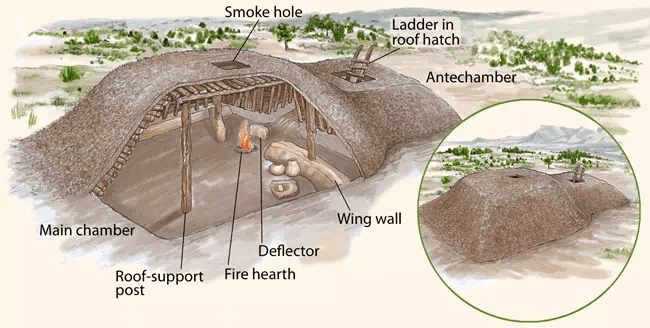Class 6 History Chapter 2 Question Answers - From Hunting-Gathering to Growing Food
Q1: Name the place where the site of Burzahom is situated.
Ans : Kashmir
Q2: What archaeological evidence has been found in Burzahom?
Ans : The archaeological evidence that have been found from this site include wheat, lentil, goat, buffalo, sheep and dogs.
Q3: The evidence of pit-house has been found from __________.
Ans : Burzahom
 Burzahom Pit-House
Burzahom Pit-House
Q4: Pit-houses have been constructed to get protection from the cold temperatures. True/False
Ans : True
Q5: Name One of the important occupations taken up by the tribes of the Middle Stone Age.
Ans : Herding
Q6: Burial is an arrangement for ________________.
Ans : Weak people
Q7: Name the place where several burial sites had been found.
Ans : Mehrgarh
Q8: The most common animal, generally kept by the people in Mehrgarh.
Ans : Cattle
Q9: Name one of the earliest villages to be discovered and excavated.
Ans : Mehrgarh
Q10: In the present day, Paiyampalli is located in Uttar Pradesh. True/False.
Ans : False
Q11: What did the Findings at Mehrgarh include?
Ans : 4 or more compartmented houses in the shape of a square
Q12: According to archaeologists, what is the reason behind burying goats along with the dead bodies?
Ans : To serve as food in the next world after death
Q13: People at Mehrgarh believed that there is some form of life after _________.
Ans : Death
Q14: Name the place where Cattle hoof marks were found on a clay surface.
Ans : Mahagara site
Q15: What was the purpose of making large clay pots?
Ans : to store food
Q16: The site of Koldihwa is located in______________.
Ans : Uttar Pradesh
Q17: Mention one of the reasons why people of that age stored grains.
Ans : For food
Q18: Name the place where Millet was grown in the Neolithic Age.
Ans : Paiyampalli and Hallur
Q19: According to archaeologists, people built pit houses which were dug into the ground with steps leading to them. True/False
Ans : True
Q20: What were the cooking platforms found in Burzahom?
Ans : Hearths
Q21: Name the first animal to be tamed by the early people.
Ans : wild ancestor of dog
Q22: How did early men use to tame animals?
Ans : Early men used to tame animals by leaving food for them near their shelters
Q23: For hunter-gatherers, 'store of food' was available in the form of _______________.
Ans : Animals
Q24: Grains also served one special purpose for the hunter-gatherers; what was that?
Ans : Gifts
Q25: Name the site that provides the evidence of tools made from ' fossil wood'.
Ans : Daojali Hading
Q26: List of the most distinctive features of a villager.
Ans : Being a Food producer
Q27: We find tools made of fossil wood at ____________.
Ans : Daojali, near Brahmaputra valley
Q28: Name the material used to make Handles of spears and arrows.
Ans : Daojali Hading
Q29: Materials that have been found at Gufkral site include_____________________.
Ans : Wheat and lentil
Q30: Name the site where we find the proof that the people had learnt to produce food.
Ans : Gufkral site
Q31: What do you mean by the Neolithic?
Ans : New Stone Age
Q32: Name the site from where polished stone tools had been found.
Ans : Chirand and Gufkral
Q33: The discovery of crops grown by early man is linked to the _____________.
Ans : Finding burnt grain
Q34: How did Scientists have identified that animals existed during the pre-historic period?
Ans : Through bones of animals
Q35: Why do we call Stone tools found in some regions as Neolithic?
Ans : They are not similar to the normal tools of the Paleolithic.
Q36: What was the major difference between the tribal and normal society people?
Ans : The commonwealth is divided amongst the members.
Q37: Name all the places where examples of early farming and herding can be found.
Ans : North-west, East and South India and Kashmir
Q38: The need for domestication of animals was for ___________________.
Ans : Milk and meat
Q39: The people of Burzahom are associated with the period named as _________________.
Ans : Neolithic
Q40: Name the period in which people learned to make food.
Ans : Neolithic
Q41: Name the earliest crops that were planted.
Ans : Wheat and Barley
Q42: Name the place where the famous site of Burzahom is situated.
Ans : Kashmir
Q43: Mehrgarh is considered to be the place where men and women learnt to grow ___________ and wheat.
Ans : Grow barley
Q44: What is the name of the Neolithic age?
Ans : New Stone Age
Q45: Name the site where hoof marks on the clay surface have been found.
Ans : Mahagarh
Q46: The Neolithic site “Paiyampalli” is located in ______________.
Ans : Andhra Pradesh
Q47: Name the most important pass which links India with Iran.
Ans : Bolan Pass
Q48: Name the site from where the bones of the pig were discovered.
Ans : Paiyampalli
Q49: Name the site that provides evidence of black gram.
Ans : Paiyampalli
Q50: “Daojali Hading” is located near the Ganga valley. True/False
Ans : False
FAQs on Class 6 History Chapter 2 Question Answers - From Hunting-Gathering to Growing Food
| 1. What is the transition from hunting-gathering to growing food? |  |
| 2. When did the transition from hunting-gathering to growing food occur? |  |
| 3. Why did humans transition from hunting-gathering to growing food? |  |
| 4. What were the major crops cultivated during the transition to growing food? |  |
| 5. How did the transition from hunting-gathering to growing food impact human society? |  |

















